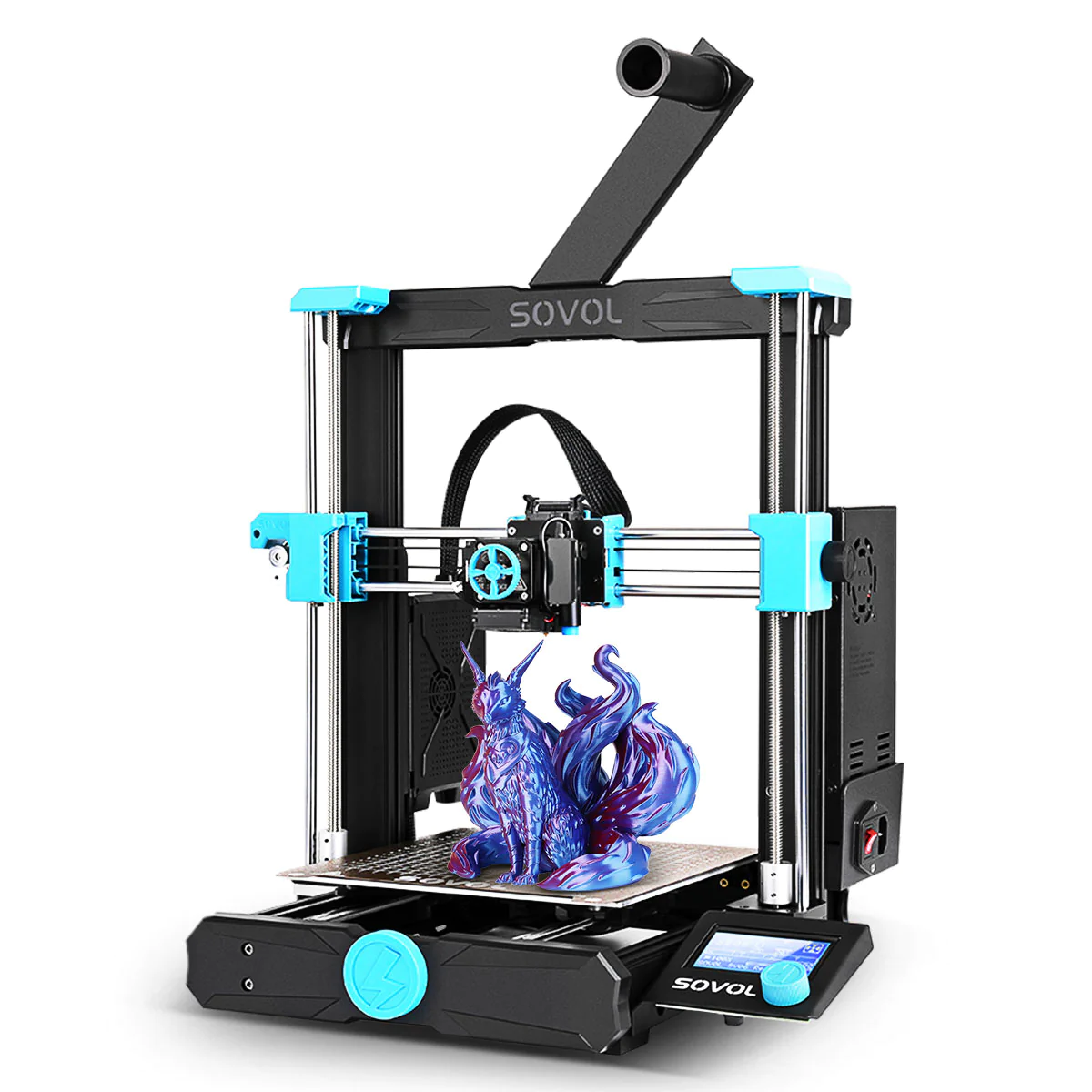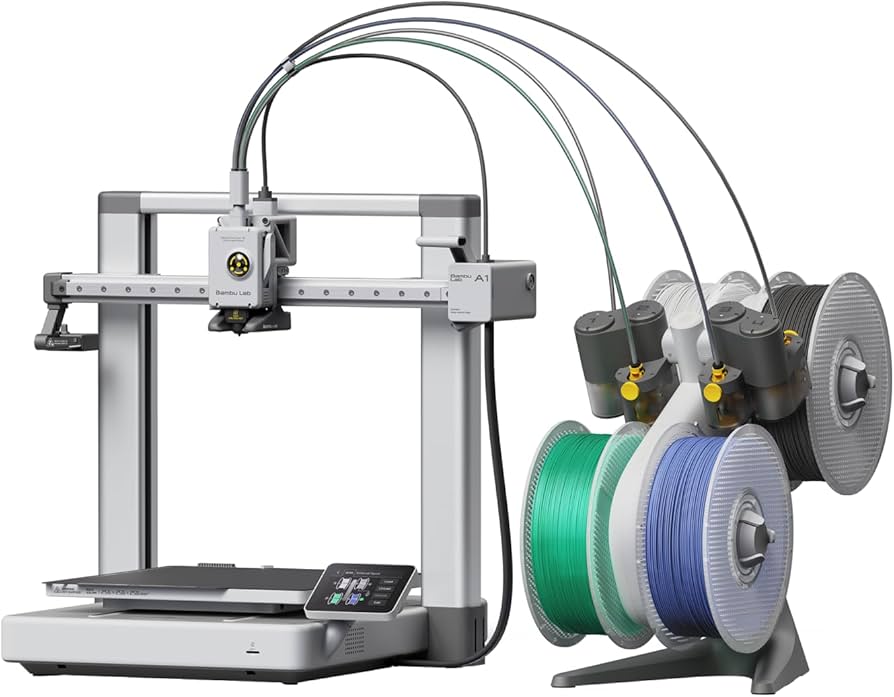Compare SV06 vs A1
Comparison between the best 3D printers
Choose the best 3D printer at the best price. The cheapest 3D printers are here.
Buy a 3D printer here with 3D Fila.
 |
 |
|
| Model | SV06 |
A1[BUY A1] |
| Printing Material | Filament | Filament |
| Buy Filament for Sovol SV06 | Buy Filament forBambu Lab A1 | |
| Estimated price | $259,00 | $700,00 |
| Manufacturer | Sovol | Bambu Lab |
| Release Year | 2022 | 2023 |
| Print Volume [mm] | 220x220x250 | 256x256x256 |
| Printer Size [mm] | 497x388x610 | 385x410x430 |
| Weight [kg] | 9 | 8,3 |
| Power Loss Recovery | YES | YES |
| Enclosed printer | NO | NO |
| Bed Leveling | Automatic | Automatic |
| Filament End Sensor | NO | YES |
| Bed type | Heated | Heated |
| Power supply system | Direct Drive | Direct Drive |
| Standard nozzle | 0,4 | 0,4 |
| Maximum Nozzle Temperature [°C] | 300 | 300 |
| Maximum Bed Temperature [°C] | 100 | 100 |
| Maximum printing speed [mm/s] | 80 | 500 |
| Filament holder | NO | YES |
| Camera for supervision | NO | NO |
| Recommended filaments | PLA, PETG, Tritan, Flex, ABS | PLA, PETG, TPU, PVA |
| Recommended slicers | Cura, Simplify, Slic3r, IdeaMaker | SuperSlicer, PrusaSlicer, Cura, OrcaSlicer |
| Maximum Resolution [mm] | 0,1 | 0,1 |
| Processor | ||
| Display | Mono | Touchscreen 3,5 |
| Power Supply | 350 W | |
| Connectivity | SD / USB | Wi-Fi, Bambu-Bus, Cartão Micro SD |
| Operating systems | Windows, Mac, Linux | Windows, Linux, Macbook |
| Date of registration in the system | 2023-03-02 | 2024-07-17 |
| Release date | 2022 | 2023 |
| Extra features | The Sovol SV06 printer stands out for having a direct-drive extruder, providing better performance when printing a variety of materials. It has linear rods for greater precision and smoothness in movements, as well as an automatic bed leveling system, eliminating manual adjustments. Its all-metal hotend supports a wide range of materials. The SV06 also features sensorless homing and Z-axis self-alignment, increasing reliability and ease of use. Compatible with Klipper software, it offers the possibility of upgrades to increase printing speed. | The BambuLab A1 printer features fully automatic calibration, multi-color printing with the AMS system, active flow rate compensation, quick nozzle change with a clip, active motor noise cancellation, a build volume of 256x256x256 mm³, a maximum extruder temperature of 300°C, and a heated bed of up to 100°C. In addition, it has high precision, a machine health management system and an intuitive 3.5-inch touchscreen interface. |
| Support for multiple colors and materials (AMS and CFS) | NO | YES |
Notes * |
||
| Cost-benefit | 6 / 10 | 7 / 10 |
| Hardware | 0.6 / 10 | 4.2 / 10 |
| Tela | . | . |
| Print volume | 3 / 10 | 4 / 10 |
| Performance | 0 / 10 | 4 / 10 |
| [BUY A1] |
Conclusion |
| In comparing the Sovol SV06 and the Bambu Lab A1 3D printers, several key factors emerge that can help potential buyers make an informed decision. The Sovol SV06 comes at a considerably lower price point, making it an attractive option for budget-conscious users. It features an automatic bed leveling system, a selection of compatible filaments, and is noted for its ease of use with capabilities for a variety of materials thanks to its direct-drive extruder. However, it has limitations in terms of print speed and lacks certain advanced features such as a filament end sensor and a touchscreen interface, which may affect convenience during operation. On the other hand, the Bambu Lab A1 commands a higher price but offers significantly enhanced capabilities. With a larger print volume and remarkably higher maximum printing speed, it caters well to users who prioritize efficiency. The inclusion of features such as multi-color printing support, a comprehensive health management system, and a user-friendly touchscreen enhances the overall user experience. This printer also demonstrates superior performance and cost efficiency in terms of features provided relative to its price. In conclusion, if budget is the primary concern and the user requires a straightforward, reliable machine for basic 3D printing needs, the Sovol SV06 is a solid choice. Conversely, for those who are willing to invest more for advanced features, faster printing, and a more refined user experience, the Bambu Lab A1 is the superior option. Ultimately, the decision hinges on specific user requirements, prioritization of features, and budget flexibility. |

